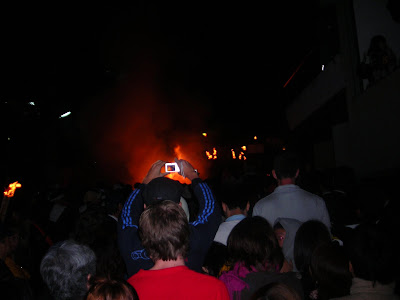As discussed in the film
"The Japanese Version", many Japanese people view foreigners in Japan like they would pandas: cute, interesting to look at and touch, fun to "play" with. As an American living in Japan, I have indeed noticed the giggles and finger-pointing in my direction. I've also played games with Japanese strangers, like "Let's Speak English" or "Let's Kampai". While it sometimes feels like admiration, it also makes me feel a sense of unbelonging. I will remain an outsider, or a panda, to Japanese people as long as it says on my birth certificate that I was born in America.

At the Gaidai Festival this past weekend, many school clubs formed their own fundraising booth to sell a certain food dish. Walking through the human highway between booths, festival attendees are bombarded with questions and marketing pleas. To international students, it's in broken English: "Excuse me. Are you hungry? Please try udon!" It is very difficult to refuse such a thing without regret, and for me my Japanese is too poor to convey a reason why I would not want udon at that moment. The photo above showcases this exact occurence, and actually features a fellow Visual Anthropology student (the tall panda in yellow) who was likely unaware of my camera.

This photo was taken in mid-September at the Danjiri Festival. We, as obvious pandas, were personally picked out of the crowd and rushed to the Tourist Information office where we were dressed and shuffled together with other young Vietnamese tourists, without any explanation. After the photo opportunity, we were escorted around the festival by
Otoosan, the lovely Japanese man on the right, who led us to the best spots to view the Danjiri floats. With red and white ropes tied around our heads, we were directly marked as pandas to attract even more attention to our cuddly selves.
To be an outsider in Japan can be difficult even when just dealing with awed strangers. There is always a sense of discomfort being an "Other", though of course any outsider treatment I receive is not nearly as severe as that which many outsiders face on a daily basis in America.
Pandas are welcome in Japan--as long as they remained unarmed.

American man in panda mask for Halloween, posing with Japanese man in a white face mask.
 The Pink Panther was made to be a sly character, but Japan turned the idea of him into a cute kitten-looking "panther pal".
The Pink Panther was made to be a sly character, but Japan turned the idea of him into a cute kitten-looking "panther pal".
 Speaking of mushrooms, I went to a bar in Kyoto called "The Mushroom Bar", that had low orange lighting, smiley faces all over the walls, and kids' toys on each table. The bar's owner had his hair shaped like a mushroom. The bar wasn't nostalgic or even kawaii, just terrifying.
Speaking of mushrooms, I went to a bar in Kyoto called "The Mushroom Bar", that had low orange lighting, smiley faces all over the walls, and kids' toys on each table. The bar's owner had his hair shaped like a mushroom. The bar wasn't nostalgic or even kawaii, just terrifying.





















